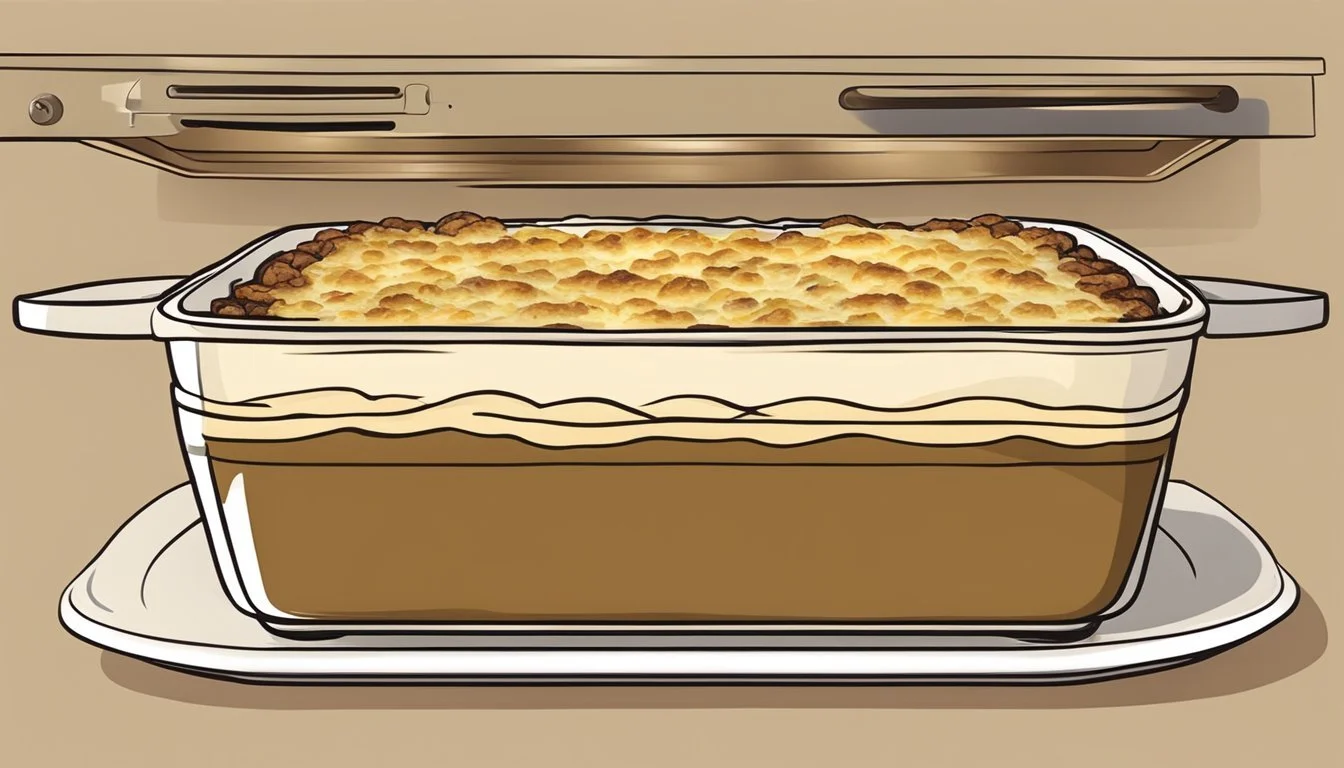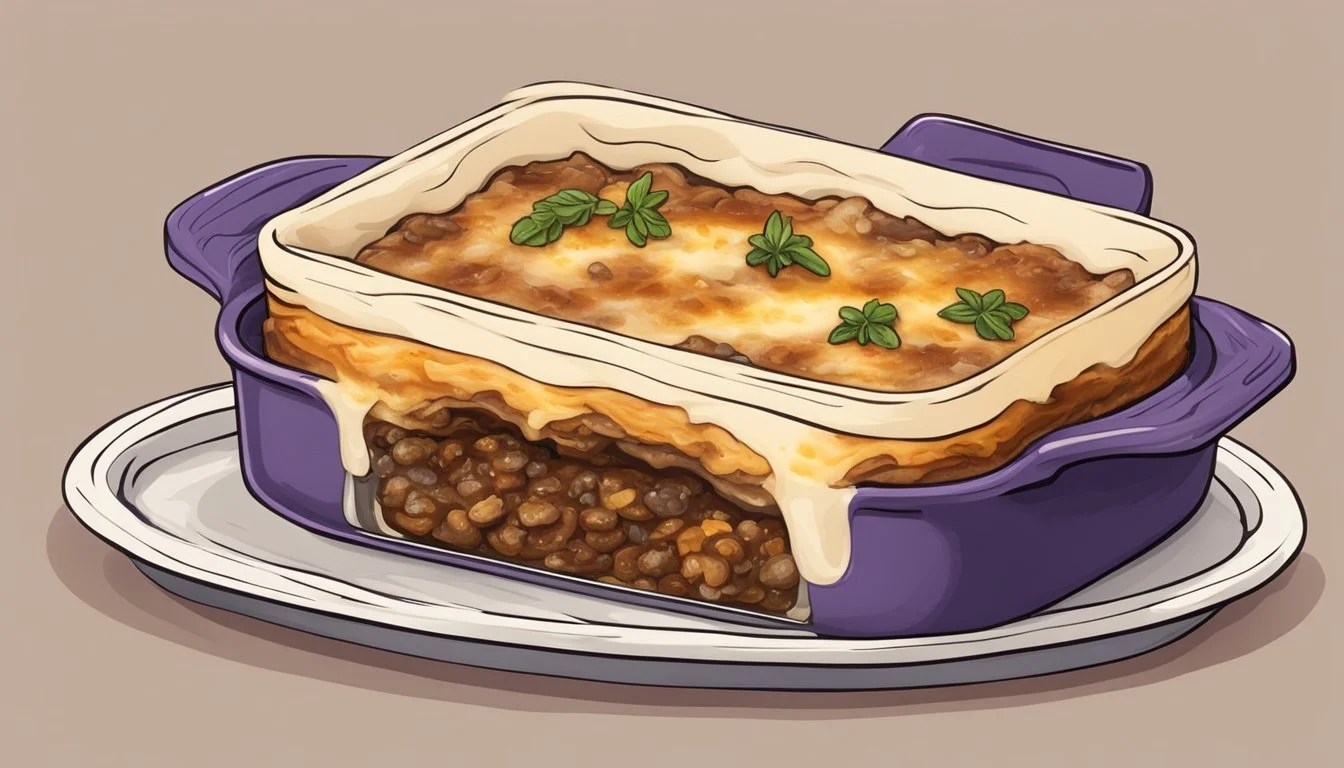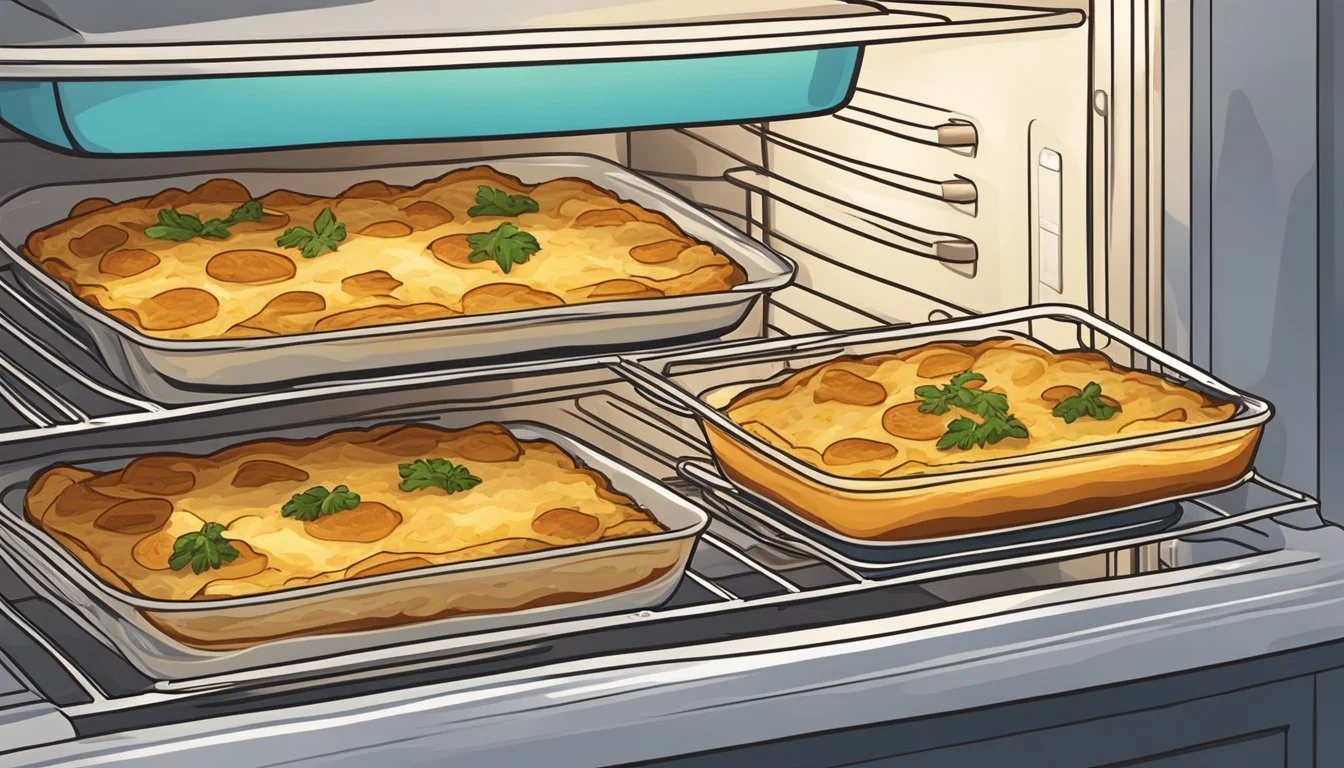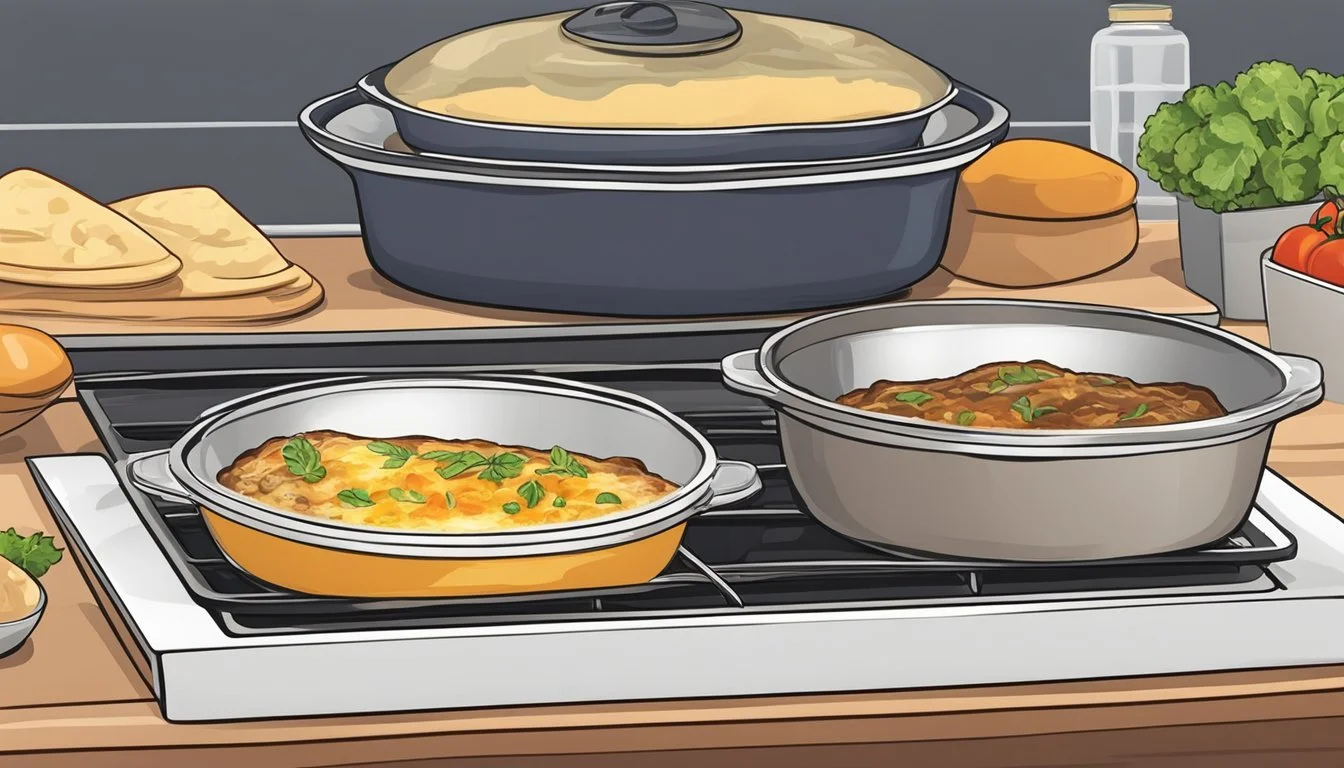Best Way to Reheat Greek Moussaka
Techniques for Maintaining Its Textural Integrity
Moussaka is a quintessential Greek comfort food, known for its rich layers of eggplant, spiced meat filling, and creamy béchamel sauce. Each layered component contributes to its overall flavor and texture, making the reheating process crucial to preserving its integrity. In the culinary world, moussaka stands out as a dish that requires careful attention when brought back to temperature, since maintaining its characteristic texture is key to enjoying it as intended.
Finding the best way to reheat moussaka is essential to keep the pleasant contrast between the tender eggplant, the savory meat, and the velvety béchamel. While a microwave might be the go-to for speed, it often falls short in heating evenly and can adversely affect the dish's layered structure. The oven, on the other hand, offers a more controlled and even reheating method, allowing the distinct layers to warm without losing their individual textures.
To accomplish this, the moussaka should be covered to retain moisture and reheated at a moderate temperature. This minimizes the risk of the béchamel separating and ensures that the dish heats through to its core. Consequently, this method provides the diner with an experience closely reminiscent of the moussaka's initial serving, with its flavors and textures restored to their original state of allure.
Understanding Moussaka Composition
Moussaka is a classic Greek casserole that demands attention to its layered structure and the harmony of its ingredients to ensure an authentic culinary experience.
Layered Structure and Ingredients
Moussaka is celebrated for its layered structure, which typically includes sliced eggplant, potatoes, and a spiced meat filling. These layers are often seasoned with a mix of cinnamon, nutmeg, oregano, and garlic, infusing the dish with distinctive flavors. Generously brushed with olive oil before baking, the eggplant and potatoes form a tender base and top, providing a textural contrast to the savory meat layer.
Eggplant: Thinly sliced and often fried or baked to achieve a soft texture.
Potatoes: Boiled or fried, offering a comforting base or layer.
Meat: Commonly ground lamb or beef, richly seasoned and cooked to perfection.
Béchamel Sauce: A creamy sauce made with butter, flour, milk, enriched with cheese, and seasoned with spices, which crowns the casserole.
These ingredients are assembled in delicate layers which contribute to moussaka's signature texture and taste.
Distinguishing Greek Moussaka
Greek moussaka stands out due to the inclusion of béchamel sauce, a creamy and cheesy topping that is delicately flavored with nutmeg and cinnamon. The presence of béchamel adds a luxurious richness and binds the layers together.
Cheese: Often parmesan or kefalotyri, adding a salty and tangy flavor to the béchamel.
Olive Oil: Used to prepare the vegetables, it imparts a fruity note characteristic of Mediterranean dishes.
This version may also feature layers of potato for additional sustenance, adhering to regional variations in Greece. Each ingredient is chosen and prepared with intention, contributing to a cohesive dish that is hearty, yet sophisticated.
Preparation Fundamentals
Crafting a delightful Greek Moussaka requires attention to detail and an understanding of each layer's interplay to maintain its signature texture and flavor.
How to Make Greek Moussaka
Greek Moussaka is a savory layered casserole traditionally comprising sliced eggplants, potatoes, and a rich meat sauce, often made with ground lamb or beef. Seasoning is pivotal – a combination of onion, garlic, cinnamon, and allspice can be used to infuse the meat sauce with a robust flavor profile. The dish is topped with a creamy béchamel sauce adding a luscious, velvety layer to the bake.
Key Components in a Basic Greek Moussaka Recipe:
Vegetable Layer: Thinly-sliced eggplants and potatoes, often fried or baked
Meat Sauce: Ground lamb or beef simmered with garlic, onions, and spices
Béchamel Sauce: A roux-based sauce enriched with milk, cheese, and a hint of nutmeg
Seasoning: Salt, pepper, cinnamon, and allspice to taste
It's essential to fully cook each layer before assembly. After layering, baking the moussaka allows the flavors and textures to meld beautifully.
Alternative Versions of Moussaka
For those seeking vegetarian or vegan options, a vegetarian moussaka can replace the traditional meat sauce with a rich, flavor-packed lentil or mushroom sauce. Dairy elements in the béchamel can be substituted with plant-based milk and vegan cheese, ensuring the sauce remains creamy while adhering to dietary preferences.
Key Components in a Vegetarian/Vegan Moussaka Recipe:
Vegetable Layer: Unchanged, with a focus on properly baked or fried ingredients
Vegetable Sauce: Lentils, mushrooms, or a blend of both with traditional moussaka seasoning
Vegan Béchamel: Plant-based milk, flour, and vegan cheese, seasoned with salt and nutmeg
Whether creating a traditional or a plant-based variant, the key is to preserve the integrity of the flavors while ensuring the final bake achieves a harmonious balance between the creamy béchamel and the seasoned base layers.
Reheating Techniques for Moussaka
Properly reheating moussaka is essential to preserve its layered texture and ensure it is enjoyed as intended. Here are three methods to reheat moussaka while maintaining its quality.
Oven Reheating Method
To reheat moussaka in the oven, one should preheat the oven to 350°F (177°C). Place the moussaka in an oven-safe dish and cover it with aluminum foil to prevent the top from drying out. This retains moisture and ensures even heating. A whole dish typically requires 30-40 minutes, while individual slices may only need about 20 minutes. It's recommended to check the moussaka periodically to avoid overheating.
Stovetop Reheating Method
For those who prefer using the stovetop, a skillet can be an effective alternative. One should heat the skillet over medium heat and transfer the moussaka slice into it. Using a skillet with a lid is ideal as it helps to retain steam and heat the moussaka evenly. To prevent burning, one can add a few tablespoons of water to the skillet and heat the moussaka gently for a few minutes until it is warmed through.
Microwave Reheating Considerations
Reheating moussaka in a microwave should be done cautiously to avoid ruining its texture. Moussaka should be placed in a microwave-safe, airtight container to help maintain its moisture. Use a lower power setting and heat in short bursts of one to two minutes, stirring or rotating in between if possible, to promote even reheating. Quick checks are necessary to prevent the edges from drying or the béchamel sauce from separating.
Optimizing Moussaka Taste and Texture
To best enjoy the robust flavors and delicate layers of Greek Moussaka, it is crucial to reheat it in a way that maintains its optimal taste and texture. Precise temperature control and a gentle reheating process are key.
Regulating Moisture Content
Moussaka's moisture content is essential to preserving its creamy consistency and preventing it from drying out. Reheating moussaka should be done slowly, at a moderate temperature of 350°F (177°C), to control moisture loss. Covering the dish with aluminum foil can prevent the top layer from becoming too dry. For ensuring the moisture is distributed evenly throughout the layers:
Preheat the oven to the recommended 350°F.
Cover the moussaka with foil.
Heat for 20 minutes for individual portions or 30-40 minutes for larger portions.
If the moussaka starts to dry on top, one can add a small amount of water or stock and cover with foil to reintroduce moisture.
Maintaining Layer Integrity
The signature layers of moussaka, rich with eggplant, meat, and béchamel sauce, can easily become compromised if reheated improperly. To preserve the layered structure, each component must come to temperature without the layers mixing or béchamel separating. Gentle reheating ensures that the flavors of salt, pepper, and the main ingredients blend well without altering the quality of the dish.
When reheating, it is recommended to:
Avoid overcooking by checking the moussaka periodically.
Use a clean knife or thermometer to test the center's temperature without disturbing the layers.
Continue reheating in increments of 5-10 minutes if not yet adequately heated, to ensure the consistency stays intact.
Moussaka Storage Insights
Proper storage of moussaka is essential to maintaining its flavorful layers and texture. Whether refrigerating leftovers for short-term consumption or freezing moussaka for longer keeping, understanding the nuances of proper storage can make a significant difference in preserving its quality.
Storing Leftover Moussaka
When it comes to refrigerating leftover moussaka, it’s imperative to allow the dish to cool to room temperature before storing to prevent condensation, which can lead to sogginess. Once cooled, the moussaka should be transferred to an airtight container or covered with plastic wrap to prevent it from absorbing other flavors or drying out. Stored this way, leftover moussaka typically remains fresh for up to 3-5 days in the refrigerator.
Freezing and Thawing Best Practices
Moussaka freezes exceptionally well due to its dense structure and baked composition. For optimal freezing results:
Cool the moussaka completely. This prevents ice crystals from forming which can alter the texture upon thawing.
Wrap tightly in plastic wrap to create an airtight seal around the dish. If additional protection against freezer burn is desired, an extra layer of foil or placement in a freezer-safe bag can be worthwhile.
Clearly label your containers with the date to ensure it's used within the ideal freezing time frame—up to 3 months for maximum flavor retention.
Thawing moussaka should be done gradually, moving the frozen dish to the refrigerator and letting it thaw overnight. This slow process helps maintain the dish’s layers and keeps the moussaka moist. Reheating should then be done in the oven, covered, to reheat it evenly without drying it out.
Serving and Pairing Recommendations
When presenting Moussaka, a quintessential Greek dish, attention to detail can make the experience truly memorable. It’s a hearty comfort food, with layers of flavors that pair beautifully with a variety of accompaniments and beverages.
Side Dishes:
Greek Salad: A classic Greek salad, with ripe tomatoes, cucumbers, red onions, olives, and feta cheese, dressed in olive oil and lemon, complements the rich layers of the Moussaka.
Crusty Bread: A slice of rustic bread can be served to sop up the delicious sauces.
For an authentic Greek dining experience, selecting the right wine to accompany Moussaka is crucial:
Red Wines: A robust Greek Agiorgitiko or Xinomavro will balance the meatiness of the dish.
White Wines: For those preferring white, a dry Assyrtiko can contrast the creamy béchamel topping.
Presentation Tips:
Serve the Moussaka warm and in moderate portions to appreciate its complex texture and flavors.
Garnish with a sprinkle of fresh parsley or mint to add a touch of color and a hint of freshness.
Remember, the goal is to enhance the Moussaka, not to overshadow it. Each pairing should highlight the dish’s rich and savory layers while adding a fresh perspective to the palate.
Cleaning Up Post-Moussaka
After enjoying a hearty Greek moussaka, cleaning up is an important step to ensure your kitchen remains hygienic and ready for future cooking endeavors. They should approach this task methodically to manage food residue and greasy utensils efficiently.
Utensil Pre-treatment: They should begin by scraping off excess food from the dishes and utensils into the trash. This helps prevent clogging the sink with particles. Soaking the utensils with warm water and a small amount of dish soap can loosen stubborn grease.
Dishwashing Strategy: Dishes used for moussaka, which may include baking dishes and serving plates, often have layers of baked-on cheese and béchamel sauce. They should use a sponge with an abrasive side to tackle these residues:
Start with the least greasy items to keep the dishwater cleaner for longer.
Replace or refresh the dishwater as it becomes too dirty or cool.
Type of Item Order in Cleaning Process Glasses and Cups First Serving Dishes Second Baking Dish Third Cutlery and Cooking Utensils Fourth Pots and Pans Last
They must always rinse the dishes thoroughly with clean water to remove any soap residue. Drying should be done with a clean towel or by air drying on a rack to avoid water spots and bacterial growth.
Baking Dish Attention: The moussaka's baking dish may require additional care. If the food is baked on, they should fill the dish with water and a drop of dish soap and allow it to soak. After an adequate soaking time, they can use a scrub brush to remove the remnants effectively.
Countertop Maintenance: Finally, they should wipe down the countertops with a kitchen spray or a vinegar solution to ensure that the area is clean and free from any food particles or bacteria. This step is imperative not only for aesthetic purposes but also for maintaining good kitchen hygiene.








